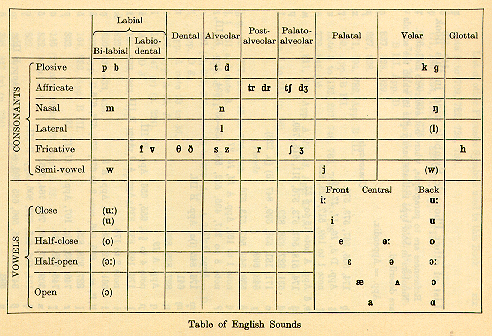
The following table shows all the English phonemes:

In the above table we can
see the detailed classification of the English consonants and the pure
vowels. Besides these there is another kind of vowels: diphthongs. They
are represented by the symbols: ei, ou, ai, au, ![]()
Comparasion between Chinese and English phonemes:
Consonants:
| Chinese | b | p | m | f | d | t | n | l | g | k | h | s | r | c | zh | ch | sh | ng | w | y |
| English | b | p | m | f | d | t | n | l | g | k | h | s | ts | w | j |
Particular Consonants in Chinese:
z, j, q, x
Particular Consonants in English:
v, z, ![]()
Similar vowels in both languages:
| Chinese | a | o | e | i | u | ai | ei | ui | ao | ou | iu | ie | er | an | en | in | un | ün | ang | eng | ing | ong |
| English | a | w |
i: | u and u: | ai | ei | wei | au | ou | jou | i |
en | in | wen | jwen | e |
i |
So we can see that except some particular sounds, the majority of both the English and Chinese sounds are quite similar.